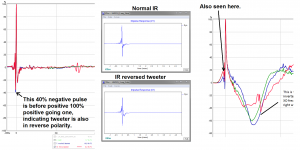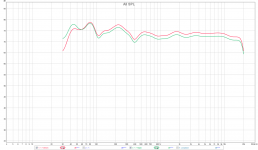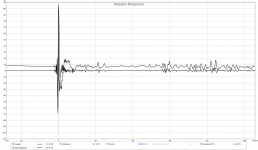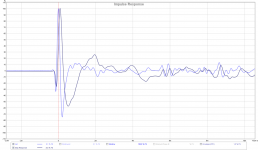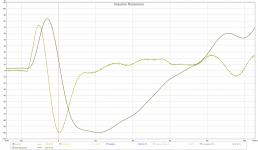Nice catch Byrtt! It appears that there is a polarity flip somewhere in the signal chain. Perhaps the Denon amp is an inverting amp? But then why is mid correct polarity?
There will be a SIGNIFICANT improvement in transient detail and snap once all this is sorted out. I suspect the speaker will jump to life like it never has before for Zschimmel.
There will be a SIGNIFICANT improvement in transient detail and snap once all this is sorted out. I suspect the speaker will jump to life like it never has before for Zschimmel.
Don't worry, I'll get it right. I'm not the giving up type  . Just want to make sure I'm understanding what I'm doing and measuring.
. Just want to make sure I'm understanding what I'm doing and measuring.
And before I forget thanks a lot everyone for helping me here, this is my first speaker build and I'm still struggling with the basics it seems.
And before I forget thanks a lot everyone for helping me here, this is my first speaker build and I'm still struggling with the basics it seems.
Last edited:
You are welcome. When I first did the 3 way Harsch, I was having a hard time too because of flipped polarity. I was so used to having to have inverted tweeter for a second order slope. Had to mentally "un-program" my brain. With lots of help and encouragement from Byrtt and Wesayso - I got it to work after a few days of tinkering.
So I went back to the beginning and checked my first LR2 crossover.
setup in Najda: woofer LR2-500, LR2-500 mid LR2-3K, LR2-3k tweeter. 2 sample delay on tweeter. There is a highshelf -6dB Q12 at 225Hz on the woofer for bafflestep compensation.
Because I'm using a long (10m) minijack extension cable to go from my PC to the Denon amp I also wanted to check whether it might be causing errors. I measured SPL, phase, impuls and STEP same as yesterday 1m on tweeter axis with the blankets in place. I measured with the PC and the long cable, laptop long cable and laptop short cable. Polarities set in Najda +++ and +-+. REW v5.14 for both PC and laptop settings the same as far as i can tell.
The extension cable doesn't seem to change the measurements except for a small difference in the dip in phase. The laptop does invert impuls and STEP.
I'm going to present the graphs and my interpretation, please correct me if it is wrong.
SPL
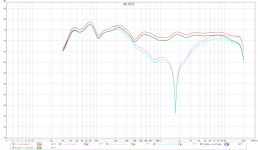
The huge dip for +++ at 1.8K does mean tweeter and mid have same polarity right? So for a correct LR2 i need to invert either mid or tweeter in Najda and for Harsch they should both be the same.
Now with the blankets there is a small dip at 400 for +-+ indicating the woofer might not be the correct polarity, however for +++ woofer and mid should sum if this is the case which they do not. It might also be caused by the very high Q shelf. A dip I didn't see before but do now since the floor reflections are greatly diminished (blankets and 4 sample window instead of 15).
Phase
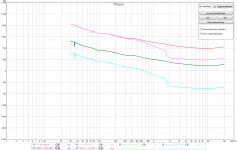
Looks normal except for the weird dip. The PC has it at 75Hz, the laptop at 35Hz. For the short cable its a deep dip, for the long cable its a small rise followed by a dip.
impuls
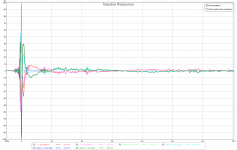
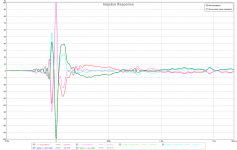
Short and long cable overlap almost perfectly, no idea about the inversion. The peak at 100µsec looks different for PC and Laptop
STEP
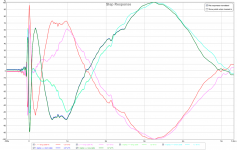
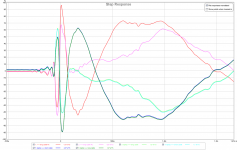
STEP peaks also look slightly different for PC and laptop, besides the inversion off course.
From these measurements is it safe to say that the Harsch I dialed in for mid-tweet is correct and the predip BYRTT mentions is due to something else then wrong polarity on tweeter?
I'll change woofer-mid LR2 crossover frequency electrical to 700, play with delays and measure +++ and +-+ again to make absolutely sure whether there is a polarity error in cabling. In any case I'll have the exact acoustic offset at 1m tweeter height needed for the woofer-mid Harsch.
setup in Najda: woofer LR2-500, LR2-500 mid LR2-3K, LR2-3k tweeter. 2 sample delay on tweeter. There is a highshelf -6dB Q12 at 225Hz on the woofer for bafflestep compensation.
Because I'm using a long (10m) minijack extension cable to go from my PC to the Denon amp I also wanted to check whether it might be causing errors. I measured SPL, phase, impuls and STEP same as yesterday 1m on tweeter axis with the blankets in place. I measured with the PC and the long cable, laptop long cable and laptop short cable. Polarities set in Najda +++ and +-+. REW v5.14 for both PC and laptop settings the same as far as i can tell.
The extension cable doesn't seem to change the measurements except for a small difference in the dip in phase. The laptop does invert impuls and STEP.
I'm going to present the graphs and my interpretation, please correct me if it is wrong.
SPL

The huge dip for +++ at 1.8K does mean tweeter and mid have same polarity right? So for a correct LR2 i need to invert either mid or tweeter in Najda and for Harsch they should both be the same.
Now with the blankets there is a small dip at 400 for +-+ indicating the woofer might not be the correct polarity, however for +++ woofer and mid should sum if this is the case which they do not. It might also be caused by the very high Q shelf. A dip I didn't see before but do now since the floor reflections are greatly diminished (blankets and 4 sample window instead of 15).
Phase

Looks normal except for the weird dip. The PC has it at 75Hz, the laptop at 35Hz. For the short cable its a deep dip, for the long cable its a small rise followed by a dip.
impuls


Short and long cable overlap almost perfectly, no idea about the inversion. The peak at 100µsec looks different for PC and Laptop
STEP


STEP peaks also look slightly different for PC and laptop, besides the inversion off course.
From these measurements is it safe to say that the Harsch I dialed in for mid-tweet is correct and the predip BYRTT mentions is due to something else then wrong polarity on tweeter?
I'll change woofer-mid LR2 crossover frequency electrical to 700, play with delays and measure +++ and +-+ again to make absolutely sure whether there is a polarity error in cabling. In any case I'll have the exact acoustic offset at 1m tweeter height needed for the woofer-mid Harsch.
How do you connect the Nadja to either PC or laptop. USB?
The pré peak signal shouldn't be there in an ideal measurement. I suspect something is up right there. Every puls seems to go up, then down before the big peak. Making it really hard to judge what is what once you start combining signals.
For clarity it would also be wise to show the impulses separately first.
You mention a LR2 crossover and if it sums one of the drivers should be reversed compared to the other. But you also mention using delay. With enough delay you can get the signal to sum without reversing the polarity. Something to keep in mind.
That's why all this gets so confusing.
Is the Nadia currently connected trough USB and can you hook it up/try it with SPDIF?
Edit: I see it's analogue in, I2S or SPDIF, no USB. So we play a signal in REW, go from digital to analogue and analogue to digital again in the Nadja if one connects it with an analogue cable. Is it currently connected with analogue cable? Do you have a way of connecting the PC to the Nadja with SPDIF?
The pré peak signal shouldn't be there in an ideal measurement. I suspect something is up right there. Every puls seems to go up, then down before the big peak. Making it really hard to judge what is what once you start combining signals.
For clarity it would also be wise to show the impulses separately first.
You mention a LR2 crossover and if it sums one of the drivers should be reversed compared to the other. But you also mention using delay. With enough delay you can get the signal to sum without reversing the polarity. Something to keep in mind.
That's why all this gets so confusing.
Is the Nadia currently connected trough USB and can you hook it up/try it with SPDIF?
Edit: I see it's analogue in, I2S or SPDIF, no USB. So we play a signal in REW, go from digital to analogue and analogue to digital again in the Nadja if one connects it with an analogue cable. Is it currently connected with analogue cable? Do you have a way of connecting the PC to the Nadja with SPDIF?
Last edited:
It's a bit confusing with all the cables and PC vs laptop. I will concentrate on PC and long cable - the red (+-+) trace because it's easy to see. For a LR2, the tweeter typically needs to be inverted so that the mid step is positive for a proper compression wave vs rarefaction wave. I see the initial downward dip on the tweeter, when in fact that should be positive accrording to label +-+, and then see upward step of the mid, again opposite of +-+. I think you system is overall inverting somewhere - doesn't matter where, but it is happening (unless it is your mic internal electronics, then of course, it is good). When you play music with a kick drum, do you see your woofer move out initially? That is one way to tell although sometimes tricky because it happens fast.
Please show data with PC and long cable and -+-. That should show mid step negative and initial tweeter peak positive. If that is so, then for Harsch, needs to be flipped to ---.
Please show data with PC and long cable and -+-. That should show mid step negative and initial tweeter peak positive. If that is so, then for Harsch, needs to be flipped to ---.
Najda is connected via USB to load DSP setups and change programming, acoustically only analogue cinch. I don't have a digital audio output on the laptop so if I wanted to hook up najda digitally it would mean a 10+ meter cable from PC. I have a 10m digital coax cable but PC only has optical out.
Getting sound digitally to najda would mean a lot of moving stuff around, I might do it
I built the Najda into an enclosure (also first electronic build) and there was a problem with the outer shield of the cinch cables touching the backpanel resulting in echoes. I since greatly increased the holes in the backpanel and coated them with nailpolish for isolation.
A 2 sample delay at 48kHz is about 0.042ms, not enough for phase rotation. It's the delay that gives the deepest null for mid-tweet with both positive polarity in Najda. (this is the normal noob-friendly way of finding the correct acoustical offset right?)
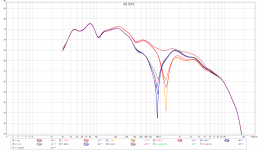
LR2 at 500 and 700 electrical all positive on Najda. This does mean i did not make an error in wiring and all + on Najda means all + (or all-) acoustical.
Getting sound digitally to najda would mean a lot of moving stuff around, I might do it
I built the Najda into an enclosure (also first electronic build) and there was a problem with the outer shield of the cinch cables touching the backpanel resulting in echoes. I since greatly increased the holes in the backpanel and coated them with nailpolish for isolation.
A 2 sample delay at 48kHz is about 0.042ms, not enough for phase rotation. It's the delay that gives the deepest null for mid-tweet with both positive polarity in Najda. (this is the normal noob-friendly way of finding the correct acoustical offset right?)

LR2 at 500 and 700 electrical all positive on Najda. This does mean i did not make an error in wiring and all + on Najda means all + (or all-) acoustical.
Last edited:
I'd still be interested to see a loop back measurement of the signal path.
Whatever RCA cable that normally feeds the amp redirected to the microphone in and run a (limited SPL) REW sweep. That would show if this signal path is causing the pré dip and peak. And it would tell us what is truly positive and negative. You can separately check every RCA.
Take away the guessing part first I'd say. A pré peak at 40% is a bit much. Granted an IR shows us mainly high frequency information. One might not even notice it. Still it isn't right.
Whatever RCA cable that normally feeds the amp redirected to the microphone in and run a (limited SPL) REW sweep. That would show if this signal path is causing the pré dip and peak. And it would tell us what is truly positive and negative. You can separately check every RCA.
Take away the guessing part first I'd say. A pré peak at 40% is a bit much. Granted an IR shows us mainly high frequency information. One might not even notice it. Still it isn't right.
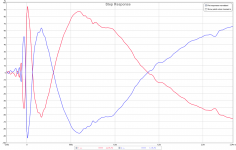
Getting the correct compression or rarefaction wave doesn't matter much now, it takes 2 seconds to change and has no influence on the other parameters. Besides PC measures opposite to laptop so which is which I'll have to check with battery.
I'll take denon AVR out and go straight from PC to Najda, see if that changes anything.
I described my whole system in post 199:
analogue out on pc soundcard to denon AVR3806 DVD-in (Audissey off)
Denon AVR3806 pre-out to Najda analogue in
Najda internal DAC
Najda analogue out to amps (sony FE520R for tweet, phillips FA880 for mid, NAD 356BEE for woofer)
Interlinks between Najda and amps are identical, no ridiculously long speaker cables
I like to keep the Denon in the system when measuring because 99% of the time I'm listening from HTPC via HDMI to Denon, it also does the crossover to the sub (I do put the crossover at 40Hz instead of 80 when measuring and keep the sub off)
Loopback measurements (if I did them correctly: minijack to dual cinch cable used for measurements, 1 cinch to female minijack dongle, male to male minijack cable to soundcard line in)
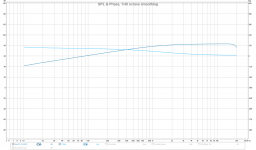
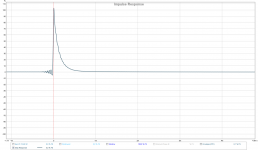
STEP from LR2 +-+ with Denon out
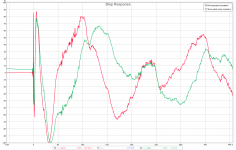
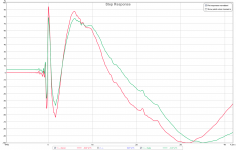
analogue out on pc soundcard to denon AVR3806 DVD-in (Audissey off)
Denon AVR3806 pre-out to Najda analogue in
Najda internal DAC
Najda analogue out to amps (sony FE520R for tweet, phillips FA880 for mid, NAD 356BEE for woofer)
Interlinks between Najda and amps are identical, no ridiculously long speaker cables
I like to keep the Denon in the system when measuring because 99% of the time I'm listening from HTPC via HDMI to Denon, it also does the crossover to the sub (I do put the crossover at 40Hz instead of 80 when measuring and keep the sub off)
Loopback measurements (if I did them correctly: minijack to dual cinch cable used for measurements, 1 cinch to female minijack dongle, male to male minijack cable to soundcard line in)


STEP from LR2 +-+ with Denon out


Try sticking to impulses first, STEP is only needed when we know where the impulses are.
What output did you measure in the loop back? It there still something changing the REW output? The STEP is short and 20 Hz is down by more than 17 dB. But it does look clean.
The slope isn't steep enough for this being the tweeter line with a crossover. But something is off.
Is this one of the Nadja out to soundcard line in?
I understand wanting to have the Denon in between. But I still see the same downwards dip before the peak here. To figure out the pré dipping it might be wise to only concentrate on one speaker driver playing. But we'd have to know why the loop back measurement has no low end first.
What output did you measure in the loop back? It there still something changing the REW output? The STEP is short and 20 Hz is down by more than 17 dB. But it does look clean.
The slope isn't steep enough for this being the tweeter line with a crossover. But something is off.
Is this one of the Nadja out to soundcard line in?
I understand wanting to have the Denon in between. But I still see the same downwards dip before the peak here. To figure out the pré dipping it might be wise to only concentrate on one speaker driver playing. But we'd have to know why the loop back measurement has no low end first.
Last edited:
The loopback measurement is PC line-out to PC line-in. .
I don't understand the question: "What output did you measure in the loop back".
I ran the exact same measurement as always except now without najda amps speaker and mic in between just line-out to line-in.
XRK do you want it with crossovers and drivers massaged to target curves or raw driver in box without any PEQ or crossover or delays?
I don't understand the question: "What output did you measure in the loop back".
I ran the exact same measurement as always except now without najda amps speaker and mic in between just line-out to line-in.
XRK do you want it with crossovers and drivers massaged to target curves or raw driver in box without any PEQ or crossover or delays?
Last edited:
I redid the Harsch target curves without the denon in the chain. (it isn't causing the predip but shouldn't have changed SPL respons so much)
Fun with graphs
now massaged when measuring with blankets and 4 sample window
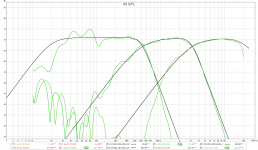
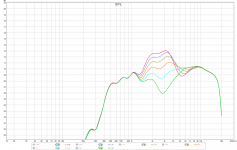
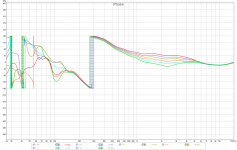
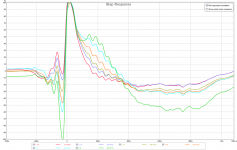
So I chose 9 sample delay as best for mid-tweet.
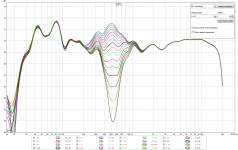
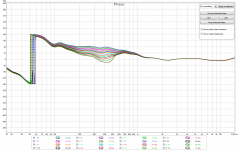
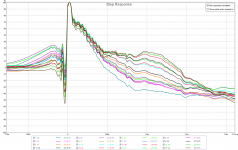
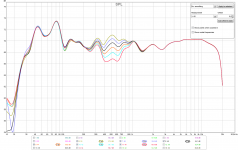
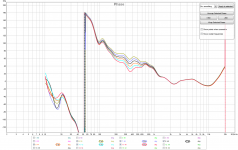
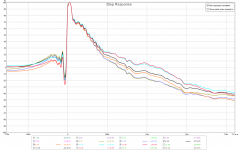
I noticed the STEP doesn't follow the logical progression of delays. For the STEP between 40-50 you would expect from bottom to top:
Greenish - blueish - black - orange
But the black and orange are inverted, no idea how relevant this is just thought it odd since everything else looks to follow the logical progression.
Fun with graphs
now massaged when measuring with blankets and 4 sample window




So I chose 9 sample delay as best for mid-tweet.






I noticed the STEP doesn't follow the logical progression of delays. For the STEP between 40-50 you would expect from bottom to top:
Greenish - blueish - black - orange
But the black and orange are inverted, no idea how relevant this is just thought it odd since everything else looks to follow the logical progression.
The loopback measurement is PC line-out to PC line-in. .
I don't understand the question: "What output did you measure in the loop back".
I ran the exact same measurement as always except now without najda amps speaker and mic in between just line-out to line-in.
XRK do you want it with crossovers and drivers massaged to target curves or raw driver in box without any PEQ or crossover or delays?
What I wanted to see is with the nadja in this loopback:
PC out -> Nadja -> PC in (that would include the extra AD-DA step in your chain)
Still wondering why the PC out to PC in loopback results in 20 Hz being 17 dB lower than 20 KHz. Resulting in an ultra short STEP.
Here's an example loopback from REW (trough JRiver) PC out -> SPDIF -> Musical Fidelity M2 DAC -> PC in -> REW

Showing both the impulse and STEP. See how the STEP continues to fly high?
The FR at 20 Hz is within a dB of the 20 KHz output.
- Home
- Loudspeakers
- Multi-Way
- S. Harsch XO
